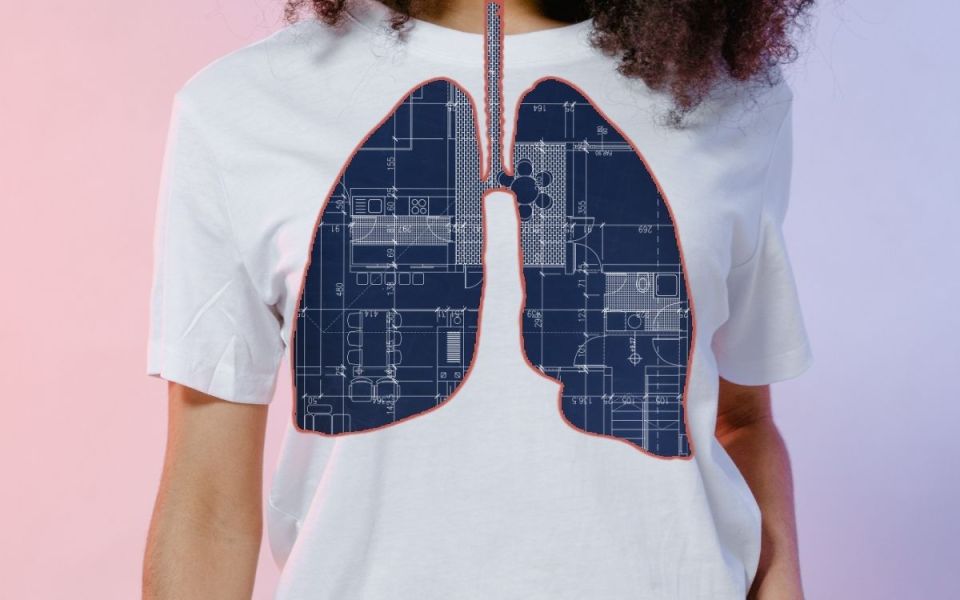Clinical Trials Have Opened Doors to COPD Medications

There’s a show on HGTV called “House Hunters” that I watched until maybe Season Five. People go look at three or so houses and choose which one they want. Some houses have little front doors and lots of tiny rooms, making them feel cozy. Others have big glass double doors and an “open concept” plan feeling big and airy. The cozy houses have lots of furniture tucked into corners, and the open-concept houses have large pieces of furniture that are sized properly for the spacious rooms. But what if a house has a big, open plan on the inside with narrow halls and small doors? Then nothing would work properly: big rooms would have small, disproportionate furniture, and any furniture assembled indoors would be difficult to get out.
This last example is like chronic obstructive pulmonary disease (COPD). With COPD, the main passageways leading to the lungs are narrowed [1]. This condition, called chronic bronchitis, results from chronic inflammation scarring and damaging the main airways [1, 2]. With emphysema, the inflammation damages the tiny air sacs called alveoli deep in the lungs, destroying the walls between them and opening the space [1, 2]. The result is lungs that have trouble filling, lungs that don’t extract oxygen from the air well, or both [1, 2]. If COPD lungs were on House Hunters, it would be a tough sell.
Chronic obstructive pulmonary disease is among the top 5 causes of death worldwide, affecting around 11% of adults over 30 [3, 4]. The inflammation that causes COPD is stimulated by continued inhalation of tobacco smoke, dust, fumes, chemicals, and other smoke - like from wildfires or barbecuing [2]. Risks increase with conditions that increase inflammation response or decrease lung function, such as genetics, developmental, or birth abnormalities [2]. Signs and symptoms include:[2, 5]
- Persistent difficulty breathing that gets worse with time or exercise
- Wheezing
- Chronic cough
- Fatigue
- Extra mucus
- Weight loss
- Lower respiratory tract infections
- Anemia (low red blood cells) which can reduce the ability to exercise
To top this off, inflammation, cellular damage, and lack of oxygen exchange can also damage the heart [6, 7, 8]. Those with COPD have a more than doubled risk of developing major cardiovascular disease [6, 7].
Considering the nearly 400 million people who have COPD, it’s no surprise there have been myriad efforts to find solutions. One of the most important first steps is to reduce modifiable risks by quitting smoking, avoiding pollution, and seeking vaccines for common respiratory infections (RSV, Flu, COVID) [2]. Back to the house analogy, inflammation is like a particularly insane neighbor going to a lifelong smoker’s house and removing the yellowed walls and closing the windows to keep the smell from leaking out; the better solution would be to stop the smoking in the first place (or reporting them to the police). Beyond risk mitigation, non-pharmacological solutions include oxygen and supervised COPD exercise rehabilitation [2].
Randomized, controlled clinical trials have found that successful treatment of COPD can help with heart issues and increase lifespans [9]. Medical solutions for COPD fall into two major categories: bronchodilators and anti-inflammatories.
Bronchodilators make it easier to breathe, either by relaxing and widening the airways or by blocking the receptors that narrow and constrict the airways [2].
- Beta2 agonist medications, such as budesonide/formoterol relax and open the airways to improve lung function [10]. The long-acting form for long-term use is called a Long-Acting Beta2 Agonist, or LABA.
- Antimuscarinic medications block the receptors of the smooth muscles that constrict and narrow the airways. Long-acting muscarinic antagonists (antagonist meaning “working against”) medications, like glycopyrrolate, are abbreviated LAMA. LAMAs can act in concert with LABA medications. Individually, each medication has limited effects. In order to make sure these medications act primarily on the lungs, they are usually inhaled.
- These combinations may improve lung function and provide relief of symptoms like shortness of breath. While these medications improve quality of life and reduce exacerbations of COPD, there is limited clinical trial data that LABA + LAMA medications improve mortality rates [2, 11].
Anti-inflammatory medications help keep that metaphorical crazy neighbor in check. Inhaled corticosteroids (ICS) have a clinical research track record of safety and effectiveness at lowering inflammation markers like CRP in the lungs [12]. These aren’t perfect on their own; they are only limited in effectiveness and may increase the risks of infections since they lower the immune response [2, 11]. The obvious solution is to combine LABA, LAMA, and ICS medications. Triple-therapy LABA+LAMA+ICS medications have shown better performance than dual-therapy LABA+LAMA medications in randomized clinical trials [13]. Current FDA-approved triple-therapy inhalers include Trelegy Ellipta and Breztri Aerosphere. These medications are more than the sum of their parts, much like a house is more than just a pile of walls, doors, and roofs. If you are suffering from COPD, consider looking into a clinical trial for new triple-therapy medications, and with luck, you may be able to catch Season 685 of House Hunters.
Creative Director Benton Lowey-Ball, BS, BFA
|
Click Below for ENCORE Research Group's Enrolling Studies |
|
Click Below for Flourish Research's Enrolling Studies |
References:
[1] World Health Organization. (January 2024). CA22 Chronic obstructive pulmonary disease. ICD-11 for mortality and morbidity statistics. https://icd.who.int/browse/2025-01/mms/en#133207228
[2] Global Initiative for Chronic Obstructive Lung Disease (GOLD). (2025). 2025 Report: Global strategy for the diagnosis, management, and prevention of chronic obstructive pulmonary disease. Available from: https://goldcopd.org
[3] Adeloye, D., Chua, S., Lee, C., Basquill, C., Papana, A., Theodoratou, E., ... & Global Health Epidemiology Reference Group (GHERG). (2015). Global and regional estimates of COPD prevalence: Systematic review and meta–analysis. Journal of global health, 5(2). https://pmc.ncbi.nlm.nih.gov/articles/PMC4693508/
[4] World Health Organization. (7 August, 2024). The top 10 causes of death. [Website, accessed 17 February, 2025]. https://www.who.int/news-room/fact-sheets/detail/the-top-10-causes-of-death
[5] Patel, M. S., McKie, E., Steiner, M. C., Pascoe, S. J., & Polkey, M. I. (2019). Anaemia and iron dysregulation: untapped therapeutic targets in chronic lung disease?. BMJ Open Respiratory Research, 6(1), e000454. https://doi.org/10.1136/bmjresp-2019-000454
[6] Chen, W., Thomas, J., Sadatsafavi, M., & FitzGerald, J. M. (2015). Risk of cardiovascular comorbidity in patients with chronic obstructive pulmonary disease: a systematic review and meta-analysis. The Lancet Respiratory Medicine, 3(8), 631-639.https://www.thelancet.com/journals/lanres/article/PIIS2213-2600(15)00241-6/abstract
[7] Crisan, L., Wong, N., Sin, D. D., & Lee, H. M. (2019). Karma of cardiovascular disease risk factors for prevention and management of major cardiovascular events in the context of acute exacerbations of chronic obstructive pulmonary disease. Frontiers in cardiovascular medicine, 6, 79. https://pubmed.ncbi.nlm.nih.gov/31294030/
[8] Curkendall, S. M., DeLuise, C., Jones, J. K., Lanes, S., Stang, M. R., Goehring Jr, E., & She, D. (2006). Cardiovascular disease in patients with chronic obstructive pulmonary disease, Saskatchewan Canada: cardiovascular disease in COPD patients. Annals of epidemiology, 16(1), 63-70. https://pubmed.ncbi.nlm.nih.gov/16039877/
[9] Stone, I. S., Barnes, N. C., James, W. Y., Midwinter, D., Boubertakh, R., Follows, R., ... & Petersen, S. E. (2016). Lung deflation and cardiovascular structure and function in chronic obstructive pulmonary disease. A randomized controlled trial. American journal of respiratory and critical care medicine, 193(7), 717-726. https://doi.org/10.1164/rccm.201508-1647OC
[10] Divo, M. J., DePietro, M. R., Horton, J. R., Maguire, C. A., & Celli, B. R. (2020). Metabolic and cardiorespiratory effects of decreasing lung hyperinflation with budesonide/formoterol in COPD: a randomized, double-crossover, placebo-controlled, multicenter trial. Respiratory Research, 21, 1-9. https://pubmed.ncbi.nlm.nih.gov/31959167/
[11] Vestbo, J., Anderson, J. A., Brook, R. D., Calverley, P. M., Celli, B. R., Crim, C., ... & Newby, D. E. (2016). Fluticasone furoate and vilanterol and survival in chronic obstructive pulmonary disease with heightened cardiovascular risk (SUMMIT): a double-blind randomised controlled trial. The Lancet, 387(10030), 1817-1826. https://www.sciencedirect.com/science/article/pii/S0140673616300691
[12] Sin, D. D., Lacy, P., York, E., & Man, S. P. (2004). Effects of fluticasone on systemic markers of inflammation in chronic obstructive pulmonary disease. American journal of respiratory and critical care medicine, 170(7), 760-765. https://pubmed.ncbi.nlm.nih.gov/15229100/
[13] Rabe, K. F., Martinez, F. J., Ferguson, G. T., Wang, C., Singh, D., Wedzicha, J. A., ... & Dorinsky, P. (2020). Triple inhaled therapy at two glucocorticoid doses in moderate-to-very-severe COPD. New England Journal of Medicine, 383(1), 35-48. https://www.nejm.org/doi/full/10.1056/NEJMoa1916046



